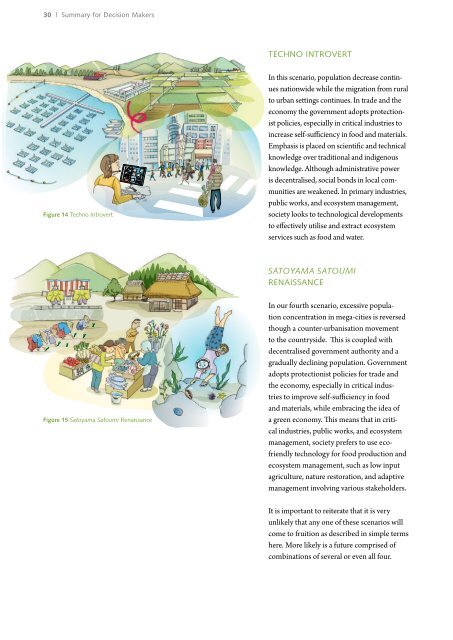Satoyama-Satoumi Ecosystems and Human Well-Being - UNU-IAS ...
Satoyama-Satoumi Ecosystems and Human Well-Being - UNU-IAS ...
Satoyama-Satoumi Ecosystems and Human Well-Being - UNU-IAS ...
You also want an ePaper? Increase the reach of your titles
YUMPU automatically turns print PDFs into web optimized ePapers that Google loves.
30 | Summary for Decision Makers<br />
Techno Introvert<br />
Figure 14 Techno Introvert<br />
In this scenario, population decrease continues<br />
nationwide while the migration from rural<br />
to urban settings continues. In trade <strong>and</strong> the<br />
economy the government adopts protectionist<br />
policies, especially in critical industries to<br />
increase self-sufficiency in food <strong>and</strong> materials.<br />
Emphasis is placed on scientific <strong>and</strong> technical<br />
knowledge over traditional <strong>and</strong> indigenous<br />
knowledge. Although administrative power<br />
is decentralised, social bonds in local communities<br />
are weakened. In primary industries,<br />
public works, <strong>and</strong> ecosystem management,<br />
society looks to technological developments<br />
to effectively utilise <strong>and</strong> extract ecosystem<br />
services such as food <strong>and</strong> water.<br />
<strong>Satoyama</strong> <strong>Satoumi</strong><br />
Renaissance<br />
Figure 15 <strong>Satoyama</strong> <strong>Satoumi</strong> Renaissance<br />
In our fourth scenario, excessive population<br />
concentration in mega-cities is reversed<br />
though a counter-urbanisation movement<br />
to the countryside. This is coupled with<br />
decentralised government authority <strong>and</strong> a<br />
gradually declining population. Government<br />
adopts protectionist policies for trade <strong>and</strong><br />
the economy, especially in critical industries<br />
to improve self-sufficiency in food<br />
<strong>and</strong> materials, while embracing the idea of<br />
a green economy. This means that in critical<br />
industries, public works, <strong>and</strong> ecosystem<br />
management, society prefers to use ecofriendly<br />
technology for food production <strong>and</strong><br />
ecosystem management, such as low input<br />
agriculture, nature restoration, <strong>and</strong> adaptive<br />
management involving various stakeholders.<br />
It is important to reiterate that it is very<br />
unlikely that any one of these scenarios will<br />
come to fruition as described in simple terms<br />
here. More likely is a future comprised of<br />
combinations of several or even all four.
















